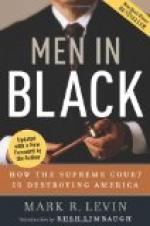Naturally with the disappearance of litigation and lawyers the public no longer tolerated the existence of the judges or courts. For a few years they retained a hold upon the imagination of a small portion of citizens who entertained a sentimental regard for the State institutions of a civilization founded upon the unsound teachings of eighteenth-century doctrinaires.
The period of the abandonment of the old courts corresponded with the extraordinary development for what was called “moving pictures”; those pale, lifeless presentations without color, speech, or substance, at which the people of a benighted age gathered for amusement or entertainment! It requires imagination to conceive that people were unfamiliar with the ease of communicating with any place on the globe and reproducing exactly in form, color, and speech by turning on a switch. The observer of that age must have been shocked and surprised to find the solemn courthouses turned into what was known as moving-picture palaces or as community centers for dancing and social entertainments.
The change of class which the lawyers had gradually been undergoing to simple men of affairs was not so abrupt as that for the judicial officers, who were far removed from actual life. Various expedients were attempted by which they could be preserved as a class. Their former occupation being gone and the idea of pensioning not being satisfactory, as there remained a large number of younger men on the bench who might be of some value to the community, a system of court cafes was evolved. Even to-day it is fast disappearing and for the benefit of future generations it may be well to describe the last remnant of an institution that held its position in the social order for so long.
Human nature being always substantially the same, it was thought that its demands for the dramatic action and stress of battle should have some outlet. It was not thought wise to entirely abolish the arenas for legal disputes, although the present Judicial Corporations with their excellently organized departments were already rapidly destroying all litigation. It was felt that perhaps humanity demanded the bringing together of the two disputants so that they personally might oppose their claims to one another.
It now seems incredible, in view of the absolute simplicity of communication by Viviphone, that this should be thought necessary. The need for romantic expression seemed to demand the opportunity for personal presentment. The social workers who established these cafe courts, did not realize that with the growth of a more intelligent public point of view, the question of abstract justice was little more than an application of customs and social standards to particular facts; and that with the fall of the ideas of justice in the abstract, there also fell the appurtenances of justice.
It may here be noted that the learned treatise of Professor Humperdinck upon the recent discovery of certain statutes found among the ruins of the Great New York Explosion is mistaken. The figure which he described among others of the woman blind-folded and with an arm extended as though holding something, does not represent as he calls it, “The poor blind girl begging,” but a figure of the Goddess of Justice holding the scales, who was so long worshiped.




